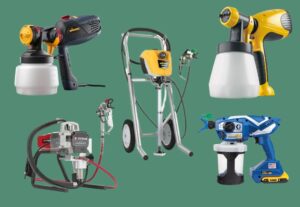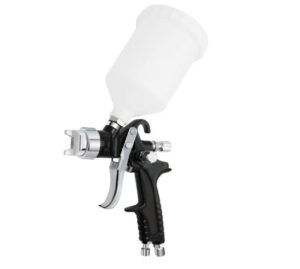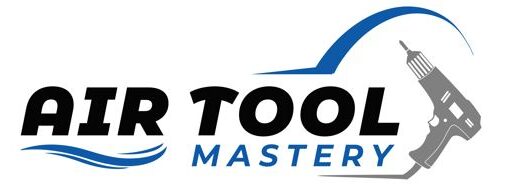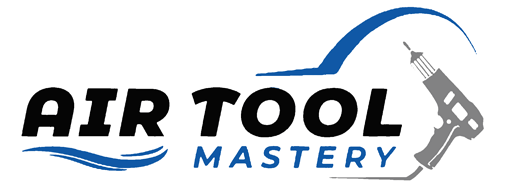Choosing the right paint sprayer for your project is key to achieving a professional finish. The market offers a variety of sprayers, each designed for specific types of work and finishes. Airless paint sprayers are powerhouse tools that deliver a fast and even coat, making them perfect for large areas like walls and exteriors. They can handle different paint viscosities, from latex to oil-based, without thinning.
For precision work and minimal overspray, HVLP (High Volume, Low Pressure) sprayers are the go-to option. They excel in fine detail applications, such as furniture and trim, using less paint and providing exceptional control. LVLP (Low Volume, Low Pressure) sprayers offer a similar advantage to HVLP but are designed for even smaller projects, requiring less air volume. These are ideal for DIYers looking for efficiency and precision.
Compression sprayers, or conventional sprayers, use compressed air to achieve a smooth finish across a variety of projects. Despite their versatility, they can be tricky to master and often produce more overspray. Lastly, electric cup sprayers are great for small tasks and touch-ups, offering convenience and ease of use for quick jobs. Each type of sprayer has its unique benefits, so understanding your project needs is essential in selecting the right one.

Types of Paint Sprayers and Their Uses
There are several types of paint sprayers, each suited for specific applications and finishes. The most common types include:
Airless Paint Sprayers: These are powerful machines that pump paint at high pressure, producing a thick, even coating swiftly. Ideal for large-scale projects like painting walls, fences, and sidings, airless sprayers can handle a variety of paint types, including latex and oil-based paints.
HVLP (High Volume, Low Pressure) Sprayers: HVLP sprayers are known for their efficiency and control, using a high volume of air at low pressure to atomize paint, resulting in a finer spray. This makes HVLP sprayers perfect for detailed work, like cabinetry, furniture, and trim, with less overspray and wasted paint.
LVLP (Low Volume, Low Pressure) Sprayers: Similar to HVLP, LVLP sprayers use even lower pressure, which requires less air volume. They are great for DIY enthusiasts and professionals who need precision on smaller projects without investing in powerful compressors.
Compression (conventional sprayers) Sprayers: These utilize compressed air to atomize the paint, creating a smooth finish. They are versatile and can be used for a range of projects, but often result in more overspray and require a skilled hand to manage.
Electric Cup Sprayers: These are handheld devices suitable for small to medium jobs, including touch-ups. Electric cup sprayers are user-friendly and convenient for those who need a quick and easy paint application.

Preparing for Paint Spraying
Safety precautions are essential when using paint sprayers, as they help to prevent accidents and health hazards. Always wear protective gear such as gloves, goggles, and a respirator mask to shield yourself from paint fumes and overspray. Make sure the workspace is well-ventilated to disperse toxic fumes, and never spray near open flames or heat sources.
Surface preparation is key to a flawless finish. Clean the surface thoroughly, removing dust, dirt, and grease, followed by sanding to create a smooth base for the paint to adhere properly. Any holes or imperfections should be filled and then sanded again. Before spraying, use painter’s tape and drop cloths to protect areas that you do not want painted.
Creating an optimal environment for paint spraying involves controlling for dust and airflow. The workspace should be as dust-free as possible, because airborne particles can ruin the paint finish. If working indoors, turn off fans and cover vents to minimize air movement that can carry dust. When spraying outdoors, choose a day with minimal wind, and avoid painting in direct sunlight, which can cause the paint to dry too quickly and unevenly.
Paint and Material Selection
Types of Paints and Finishes Suitable for Spraying
Selecting the right type of paint and finish is critical for spray painting applications. Generally, oil-based and latex paints are highly preferred due to their suitable consistency and drying times. Enamels provide a tough, durable finish on surfaces, making them ideal for items that require a protective coating, such as outdoor furniture or metal fixtures. For a more lustrous finish, high-gloss paints can also be sprayed, which are perfect for cabinets and trim where a shiny appearance is desired.
Thinning Paint for Spray Applications
Thinning paint is often necessary to achieve the right viscosity for spray application and prevent clogging of the spray gun. The thinning process varies depending on the type of paint used. For oil-based paints, mineral spirits are a common thinner, whereas water is typically used with latex paints. The manufacturer’s instructions should be followed to identify the correct thinning ratio – as too much solvent can affect color and drying time, while too little can result in an uneven spray pattern.
Tips for Paint Spraying
Spray Patterns and Techniques
To achieve a professional finish, understanding and controlling spray patterns is crucial. Most spray guns have adjustable nozzles that can produce a wide fan pattern for broad surfaces or a narrow cone for precise work. Practice spraying on scrap material, moving the gun parallel to the surface and maintaining a consistent distance to avoid runs and sags. Overlap each pass by about 30% to ensure even coverage.
Controlling Overspray and Achieving Even Coverage
Minimizing overspray saves paint and keeps the surrounding area clean. Use masking tape and paper to cover areas not being painted. When spraying, begin with the gun aimed away from the surface and move into it with smooth, steady strokes to limit excess spray. Consistent hand speed and pressure are vital for even coverage.
Understanding and Adjusting the Viscosity and Spray Rate
Viscosity — the paint’s thickness — affects how it flows through the gun and lays on the surface. Use a viscosity cup to measure and adjust according to the paint’s specifications. The spray rate can be regulated using the gun’s flow control mechanism, ensuring that the amount of paint released is neither too sparse nor too heavy.
Tips for Spraying Different Surfaces
Preparation is key when painting different surfaces. For non-porous materials, use the appropriate primer and allow it to dry completely. For porous surfaces like wood, sanding between coats may be necessary for a smooth finish. Always consider the material’s nature and adjust the spraying technique accordingly for the best results.
Understanding the Importance of Proper Cleanup After Spraying
After completing a painting project, it is crucial to properly clean and maintain your spray gun. This will ensure that it continues to perform well for future projects. Thoroughly flushing out any remaining paint and cleaning all parts of the gun with appropriate solvents or water can prevent clogs and damage to the gun’s components. Proper storage and maintenance of the spray gun will also extend its lifespan, saving you time and money in the long run.
Safety Precautions for Spraying
When working with spray guns, it is important to take safety precautions to protect yourself and those around you. Always wear protective clothing, including a respirator mask, goggles or glasses, and gloves when handling paint and using spray equipment. Make sure to work in a well-ventilated area and never smoke or have open flames nearby when spraying. In addition, properly dispose of any leftover paint and cleaning solvents according to local regulations.
Maintenance and Cleaning of Paint Sprayers
Best Practices for Cleaning and Maintaining Equipment
Regular maintenance of paint sprayers is essential for optimal performance. It’s recommended to run a cleaning solution through the sprayer after each use. For water-based paints, use soapy water; for oil-based paints, use mineral spirits or paint thinner. Disassemble the nozzle and any other parts that come into contact with the paint and clean them separately. Inspecting O-rings and seals during cleaning and applying lubricant as needed can prevent leaks and maintain good condition.
Storing Equipment When Not in Use
Proper storage is critical to extending the life of paint sprayers. Always store your paint-spraying equipment in a dry, dust-free environment to prevent rust and contamination. Before storing, ensure all the parts are completely dry to avoid mold growth. If possible, hang the sprayer vertically to keep its internal components free from strain.
When to Replace Parts and What to Look For
Frequent inspection of your paint sprayer for wear and tear can help prevent issues. Replace any parts that show signs of damage, such as cracked seals or eroded nozzles, as these can affect performance and finish quality. Keep an eye on the spray pattern; an inconsistent pattern may suggest it’s time to replace the spray tip. Manufacturers often provide guidelines on the lifespan of various parts, which can be a helpful reference for maintaining your equipment.
Conclusion
To effectively harness the versatility of paint sprayers, it is crucial to remember the core techniques discussed. Ensure equipment is clean when switching colors to maintain purity, and practice patience by allowing layers to dry for gradient perfection. Embrace the art of textured finishes through mastery over the sprayer’s settings and nozzle choices. And for complex patterns, precision masking can make a world of difference.
Should you wish to expand your knowledge, several resources are available. Online tutorials, DIY workshops, and community classes offer hands-on experience and professional tips. Dedicate yourself to refining your skills, and soon enough, transforming surfaces into works of art will feel second nature.

